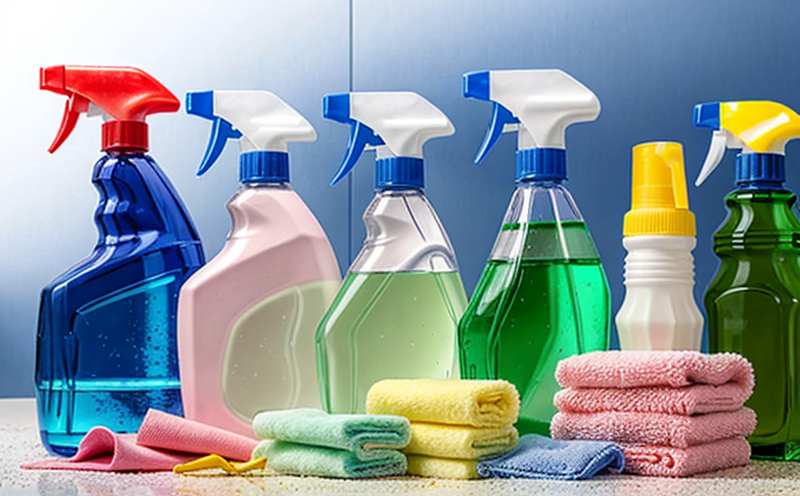Phosphate Content Testing in Cleaning Products
The testing of phosphate content in cleaning products is a critical aspect within the broader sector of consumer product and product safety testing. Phosphates, particularly triphosphates (TPP) and tetrapotassium pyrophosphate (TSP), are widely used as water softeners and soil builders in detergents to improve their effectiveness by breaking down complex soils more efficiently. However, due to environmental concerns related to eutrophication and the depletion of natural phosphorus resources, there is a growing emphasis on reducing phosphate levels.
The primary test for phosphate content involves determining the total amount of soluble phosphorus in the cleaning product. This can be achieved through several methods including gravimetric analysis or colorimetry with specific reagents. The target concentration of phosphates varies depending on the type of detergent and its intended use, but generally falls within a range that balances effectiveness and environmental impact.
For instance, laundry detergents typically contain between 0.2% to 1% phosphate by weight, while dishwashing liquids might have a higher tolerance due to their specific formulation needs. The testing process begins with the preparation of a sample solution from the detergent, which is then analyzed using an appropriate analytical method such as spectrophotometry or atomic absorption spectroscopy.
The importance of accurate phosphate content measurement cannot be overstated for several reasons. Firstly, it ensures compliance with local and international standards like ISO 15679 for detergents and cleaning agents. Secondly, it helps manufacturers optimize their product formulations to enhance performance while minimizing environmental impact. Lastly, it provides transparency to consumers regarding the ecological footprint of their purchasing decisions.
Environmental and sustainability considerations play a significant role in this testing process. Reducing phosphate levels not only mitigates water pollution but also supports sustainable resource management practices. By adhering to stringent test protocols, companies can contribute positively towards global environmental goals without compromising on product quality or consumer satisfaction.
Why Choose This Test
Selecting phosphate content testing for cleaning products offers numerous advantages that cater specifically to the needs of various stakeholders within the industry. For quality managers and compliance officers, this test ensures strict adherence to regulatory requirements set forth by organizations such as ASTM D7461 or EU directives related to detergent composition.
R&D engineers benefit greatly from accurate phosphate content testing as they can fine-tune their formulations based on precise measurements obtained during the analysis. This allows for innovation in creating more effective yet environmentally friendly products. Procurement teams also find value in this service since it helps them source raw materials and ingredients that meet specific criteria regarding phosphate content.
Moreover, conducting such tests enhances brand reputation by demonstrating a commitment to responsible manufacturing practices. It reassures consumers about the safety and eco-friendliness of their purchasing choices. In an increasingly competitive market where sustainability is becoming more important, being able to offer products with controlled phosphate levels can give businesses a significant edge.
By opting for phosphate content testing in cleaning products, organizations demonstrate leadership in addressing pressing environmental issues while maintaining high standards of product quality and customer satisfaction.
Customer Impact and Satisfaction
The implementation of stringent phosphate content tests has several positive impacts on customers. Firstly, it ensures that the cleaning products they purchase do not contribute to water pollution if used as directed. This is particularly relevant for households located near freshwater bodies or in regions where there are strict regulations against phosphorus-based pollutants.
Secondly, satisfied customers appreciate knowing that their choice of detergent supports sustainable resource management practices. They can feel confident about the long-term impact of their purchases on both human health and the environment. This sense of responsibility fosters loyalty among environmentally conscious consumers who value transparency in corporate actions.
Furthermore, clear communication regarding phosphate levels enhances trust between brands and customers. When companies openly share results from these tests, it builds credibility and reinforces the brand's image as a leader in responsible business practices. Such openness can lead to increased sales and better customer relations overall.
Environmental and Sustainability Contributions
The reduction of phosphate content in cleaning products plays a crucial role in protecting aquatic ecosystems from harmful algal blooms caused by excess nutrients entering waterways. Phosphorus pollution has been linked to numerous environmental problems including oxygen depletion, fish kills, and loss of biodiversity.
By participating in phosphate content testing, companies contribute significantly to reducing these adverse effects. For example, a single gram of phosphorus can cause rapid growth of algae leading to significant ecological disruptions when released into natural water bodies. Therefore, lowering the amount of phosphates used in cleaning products helps prevent such detrimental outcomes.
Additionally, adopting sustainable practices like minimizing phosphate use supports broader efforts aimed at conserving natural resources and promoting circular economy principles within industries. This aligns with global initiatives focused on reducing waste generation and enhancing resource efficiency throughout supply chains.





